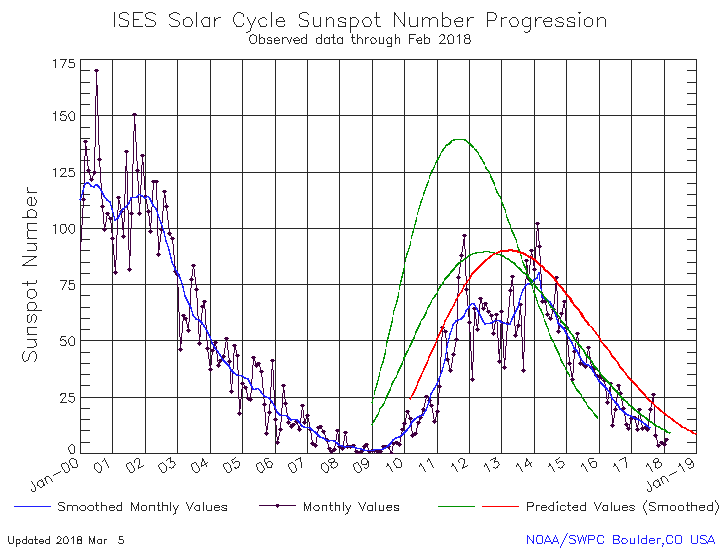Sunspot update for February 2018
It’s time for my monthly sunspot update. On Sunday NOAA posted its monthly update of the solar cycle, covering sunspot activity for February 2018. Below the fold is my annotated version of that graph.
Sunspot activity in February continued the low activity seen in November, December, and January, with November 2017 still the most inactive month for sunspots since the middle of 2009. In fact, the low activity we are seeing now is somewhat comparable to the low activity seen during the ramp down to solar minimum in the first half of 2008. By the end of that year we had hit solar minimum, the deepest and longest in a hundred years, suggesting that we might even hit solar minimum before the end of this year. That would have this happen at least a year earlier than all predictions.

The graph above has been modified to show the predictions of the solar science community. The green curves show the community’s two original predictions from April 2007, with half the scientists predicting a very strong maximum and half predicting a weak one. The red curve is their revised May 2009 prediction.
Overall, this solar cycle appears to be the weakest in more than a century. As noted at this link, “most scientists currently alive have never seen such a weak cycle.” The article at the link outlines the numerous indicators that support this, outside of sunspots, including radio flux, proton events, flares, and geomagnetic disturbances.
A look at the graph above shows this as well. The red and green lines show the predictions of the solar science community. Actual activity has never come close to matching any of these predictions. The ramp up started later then every prediction, never got as active as any prediction predicted, and started ramp down sooner than expected. Right now, if solar minimum happens in 2018, this solar cycle will only be ten years long, one of the shortest solar cycles on record.
Historically, all past short solar cycles were also very active solar cycles, so having a short but weak cycle would also be unprecedented.
None of this might happen. As I noted in my update last month, a close look at the previous ramp down in 2007 and 2008 shows that when activity became this weak, the ramp down slows. It could be that the Sun will remain in this wimpy state for at least another year before sunspot activity ceases.
Regardless, the low sunspot activity at this time continues to suggest that the next maximum will also be weak, and might even not come at all, as some solar scientists have proposed. Instead, we might be heading toward another Grand Minimum, with no significant sunspots for decades.
Will that Grand Minimum produce cold weather worldwide, as it appears to have happened during the last Grand Minimum in the 1600s? At present scientists do not have a clear link between that lack of sunspot activity and the cold weather that dominated the climate at that time, creating what some scientists dub the Little Ice Age. One link might be cosmic rays. During minimum more cosmic rays hit the upper atmosphere, and research at CERN has suggested that the cosmic rays can interact with atmospheric water and produce more clouds, thus cooling the planet.
This remains unproven however. More important, we have never had the opportunity to study the Sun with our modern satellite instrumentation during a Grand Minimum. The knowledge we could gain will be priceless in helping reduce the vast uncertainties that presently dominate the solar, climate, and astronomical fields.
On Christmas Eve 1968 three Americans became the first humans to visit another world. What they did to celebrate was unexpected and profound, and will be remembered throughout all human history. Genesis: the Story of Apollo 8, Robert Zimmerman's classic history of humanity's first journey to another world, tells that story, and it is now available as both an ebook and an audiobook, both with a foreword by Valerie Anders and a new introduction by Robert Zimmerman.
The print edition can be purchased at Amazon or from any other book seller. If you want an autographed copy the price is $60 for the hardback and $45 for the paperback, plus $8 shipping for each. Go here for purchasing details. The ebook is available everywhere for $5.99 (before discount) at amazon, or direct from my ebook publisher, ebookit. If you buy it from ebookit you don't support the big tech companies and the author gets a bigger cut much sooner.
The audiobook is also available at all these vendors, and is also free with a 30-day trial membership to Audible.
"Not simply about one mission, [Genesis] is also the history of America's quest for the moon... Zimmerman has done a masterful job of tying disparate events together into a solid account of one of America's greatest human triumphs."--San Antonio Express-News


As a friend says: “We know there is a link between green grass and the number of umbrellas left on buses in the UK. The most umbrellas left coincide with the grass being lush and green.” Rain turns the grass green but green grass is not the cause. More power to solar dynamacists for this once in a millennium event.
However, even with data to refute the CO2 model, I would not be surprised to see those advocates come up with some other manner for man to be the big problem (and invest in alternative).